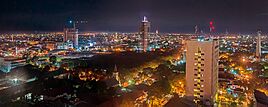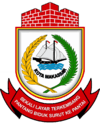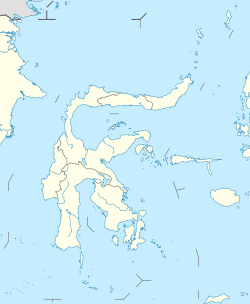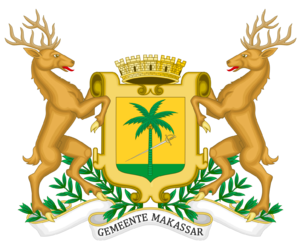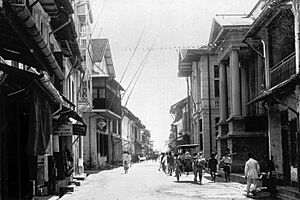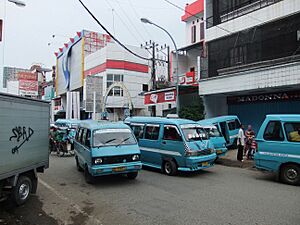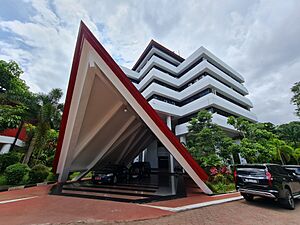Makassar facts for kids
Quick facts for kids
Makassar
Ujung Pandang
|
|||
|---|---|---|---|
|
City
|
|||
| City of Makassar Kota Makassar |
|||
| Regional transcription(s) | |||
| • Makassarese | Mangkasara’ / Jumpandang مَعْۨكَاسَارَاءْ / جُومْڡَۨانْدَاعْۨ (Serang) ᨆᨀᨔᨑ / ᨍᨘᨄᨉ (Lontara’) |
||
| • Buginese | Mangkasa’ / Juppandang مَعْۨكَاسَاءْ / جُوڡَّۨانْدَاعْۨ (Sérang) ᨆᨃᨔ / ᨍᨘᨄᨉ (Lontara’) |
||
|
Makassar skyline
Fort Rotterdam
Losari promenade
Fort Somba Opu
99 Domes Mosque
|
|||
|
|||
| Nickname(s):
"City of Daeng"; "Ujung Pandang"
|
|||
| Motto(s):
Sekali Layar Terkembang Pantang Biduk Surut ke Pantai
(Once the sails are set, we shan't return to shore) |
|||
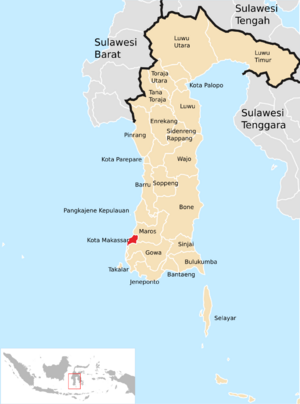
Location within South Sulawesi
|
|||
| Country | |||
| Region | Sulawesi | ||
| Province | |||
| Founded | 9 November 1607 | ||
| Area | |||
| • City | 175.77 km2 (67.87 sq mi) | ||
| • Metro | 2,666.63 km2 (1,029.59 sq mi) | ||
| Elevation | 0–25 m (0–82 ft) | ||
| Population
(mid 2023 estimate)
|
|||
| • City | 1,474,393 | ||
| • Density | 8,388.19/km2 (21,725.3/sq mi) | ||
| • Metro | 2,795,639 | ||
| • Metro density | 1,048.3790/km2 (2,715.289/sq mi) | ||
| mid 2023 official estimate | |||
| Demonym(s) | Makassarian | ||
| Time zone | UTC+8 (Indonesia Central Time) | ||
| • Summer (DST) | UTC+8 (not observed) | ||
| Area code | (+62) 411 | ||
| Vehicle registration | DD | ||
| Nominal GDP | 2023 | ||
| - Total | |||
| - Per capita | |||
| - Growth | |||
| HDI (2023) | |||
Makassar (/məˈkæsər/ muh-KASS-uhr), once called Ujung Pandang, is a big city in Indonesia. It is the capital of the South Sulawesi province. Makassar is the largest city in Eastern Indonesia. It's also the fifth-largest urban area in the country. The city sits on the southwest coast of Sulawesi island. It faces the Makassar Strait.
For a long time, Makassar has been an important trading port. It was once the center of the Gowa Sultanate. The Portuguese also had a naval base here. Later, the Dutch East India Company took control in the 17th century. It stayed a key port during the Dutch colonial period. Makassarese fishers even traveled to the Australian coast. After Indonesia became independent, Makassar was briefly the capital of the State of East Indonesia.
The city covers about 175.77 square kilometers. In mid-2023, about 1.47 million people lived there. Its larger metropolitan area, called Mamminasata, is much bigger. It covers about 2,666 square kilometers. This area had about 2.79 million people in mid-2023.
Makassar is one of Indonesia's four main central cities. The others are Medan, Jakarta, and Surabaya. It also has the second-highest commercial property values in Indonesia, after Greater Jakarta.
Contents
City Names and Their History
The city's name, Makassar, was often spelled Macassar in English. The Portuguese spelled it Macáçar. The Dutch used both Makasser and Makassar. When Indonesia became independent, the spelling Makassar was kept.
On September 1, 1971, the city's name was changed. It became Ujung Pandang. This name came from an older name for Fort Rotterdam. The change happened as Makassar grew bigger. It was meant to make the name less tied to one ethnic group.
However, many local people did not like the name Ujung Pandang. So, on October 13, 1999, the name went back to Makassar. This happened under President B. J. Habibie. He was from South Sulawesi.
In the local Makassarese language, the city is called Mangkasara′. It is written ᨆᨀᨔᨑ in the Lontara script. This script is used for both Makassarese and Buginese.
A Look at Makassar's Past
The trade of spices was very important in Sulawesi's history. Different groups fought to control this valuable trade. Spices from this region were highly wanted in the West. Much of South Sulawesi's early history is found in old texts. These texts date back to the 13th and 14th centuries.
Makassar is mentioned in the Nagarakretagama. This is a Javanese poem from the 14th century. It says Makassar was an island under the Majapahit kingdom.
Makassarese Kingdom's Rise
The 9th King of Gowa, Tumaparisi Kallonna (1512–1546), made an important alliance. He joined with the nearby trading area of Tallo. This partnership lasted throughout Makassar's time as a strong, independent kingdom.
The main center of this dual kingdom was at Sombaopu. This was about 10 km south of today's city center. An international port and a fortress were built there. Traders from Malay and Portugal started using this port. They traded with the Spice Islands (Maluku).
After 1600, the Dutch gained power over the spice trade. This made Makassar even more important. It was an open port for all traders. It also supplied rice to Maluku, which needed it.
The Dutch East India Company (VOC) wanted to control the spice trade. But the Makassar kings believed in free trade. They allowed any visitor to do business in their city. They refused the Dutch attempts to create a monopoly.
Makassar relied on Muslim Malay and Catholic Portuguese sailors. These groups were key to its economy. The English, Danish, Chinese, Spanish, and Indian traders were also important. When the Dutch took over Portuguese Melaka in 1641, Makassar became the largest Portuguese base in Southeast Asia.
By the 16th century, Makassar was Sulawesi's main port. It was the center of the powerful Gowa and Tallo sultanates. These kingdoms had many fortresses and a strong sea wall.
Makassar was well-led in the early 17th century. It resisted Dutch pressure to stop its trade with Maluku. It also made friends with nearby Bugis states. Karaeng Matoaya (1593-1636) was a wise leader. He helped the young Sultan Alaud-din become king in 1593. He guided the kingdom to accept Islam in 1603. The first official Friday Prayer in the city was on November 9, 1607. This date is now celebrated as the city's anniversary.
Karaeng Pattingalloang (1600–54) was Matoaya's brilliant second son. He became Chancellor in 1639. He spoke Portuguese very well. He loved to read books in Portuguese, Spanish, and Latin. He was very interested in math and astronomy.
Dutch Rule and Changes
After Pattingalloang died in 1654, things changed. A new king, Sultan Hasanuddin, broke the alliance with Tallo. Conflicts grew, and the Bugis rebelled. The Dutch VOC took this chance to conquer Makassar. They did this with the help of the Bugis (1667–69).
The Dutch first took the northern fort of Ujung Pandang in 1667. In 1669, they destroyed Sombaopu. This was one of the biggest battles in 17th century Indonesia. The VOC moved the city center north. They rebuilt the Ujung Pandang fort and called it Fort Rotterdam. From here, they destroyed the Gowa Sultan's strongholds. The Sultan then had to live outside Makassar. Later, Prince Diponegoro was exiled to Fort Rotterdam until he died in 1855.
After the Dutch arrived, a large Portuguese community lived there. It was called Borrobos. The leader of this community around 1660 was Francisco Vieira de Figueiredo.
The city changed as a walled area called Vlaardingen grew. But Arabs, Malays, and Chinese traders still came. They traded outside the fortress walls.
The town became a place to collect goods from eastern Indonesia. These included copra, rattan, Pearls, trepang, and sandalwood. It was also known for oil made from bado nuts. This oil was used in Europe for men's hair. This is where the name anti-macassars comes from. These were cloths used to protect chair headrests.
The Dutch controlled the coast. But they only gained power over the southern interior in the early 20th century. They made treaties with local rulers. Dutch missionaries also converted many Toraja people to Christianity. By 1938, Makassar had about 84,000 people. Writer Joseph Conrad called it "the prettiest and perhaps, cleanest looking of all the towns in the islands."
During World War II, about 1000 Dutch soldiers defended Makassar. The Japanese landed near Makassar on February 9, 1942. The Dutch soldiers were soon captured.
Makassar After Independence
In 1945, Indonesia declared its independence. In 1946, Makassar became the capital of the State of East Indonesia. This was part of the United States of Indonesia. In 1950, there was fighting in Makassar. This was between pro-Federalist forces and Republican forces. This event is known as the Makassar uprising.
Makassar's Location and Weather
Makassar is the capital of South Sulawesi province. It is in the southern part of Sulawesi Island. To the north, it borders Maros Regency. To the east, it borders Maros Regency. To the south, it borders Gowa Regency. To the west, it faces the Makassar Strait. The city covers 175.77 square kilometers.
Makassar is a coastal city. It stretches along the western and northern areas. It is known as the "Waterfront City." Several rivers flow through it, like the Tallo, Jeneberang, and Pampang rivers. All these rivers flow into the city. Makassar is a flat area, only 0-25 meters above sea level.
Makassar's Climate
Makassar has a tropical monsoon climate. This means it has wet and dry seasons. The average yearly temperature is about 27.5°C (81.5°F). Temperatures don't change much because it's near the equator. The average high is around 32.5°C (90.5°F). The average low is around 22.5°C (72.5°F) all year.
Rainfall changes a lot between months. This is due to the Intertropical Convergence Zone. Makassar gets about 3086 mm (121.5 inches) of rain each year. This rain falls on about 163 days. August is the driest month. It only gets about 15 mm (0.6 inches) of rain on one day.
During the wet season, from December to February, it rains a lot. Makassar can get over 500 mm (20 inches) of rain per month. January is the wettest month. It can get 734 mm (28.9 inches) of rain on twenty-seven rainy days.
| Climate data for Makassar (1991–2020 normals) | |||||||||||||
|---|---|---|---|---|---|---|---|---|---|---|---|---|---|
| Month | Jan | Feb | Mar | Apr | May | Jun | Jul | Aug | Sep | Oct | Nov | Dec | Year |
| Mean daily maximum °C (°F) | 31.0 (87.8) |
31.2 (88.2) |
31.7 (89.1) |
32.1 (89.8) |
32.4 (90.3) |
32.0 (89.6) |
31.7 (89.1) |
32.0 (89.6) |
32.7 (90.9) |
33.1 (91.6) |
32.7 (90.9) |
31.3 (88.3) |
32.0 (89.6) |
| Daily mean °C (°F) | 27.7 (81.9) |
27.7 (81.9) |
27.9 (82.2) |
28.2 (82.8) |
28.4 (83.1) |
27.9 (82.2) |
27.6 (81.7) |
27.8 (82.0) |
28.2 (82.8) |
28.7 (83.7) |
28.5 (83.3) |
27.9 (82.2) |
28.0 (82.4) |
| Mean daily minimum °C (°F) | 25.0 (77.0) |
24.9 (76.8) |
25.1 (77.2) |
25.3 (77.5) |
25.4 (77.7) |
24.8 (76.6) |
24.1 (75.4) |
24.0 (75.2) |
24.3 (75.7) |
24.9 (76.8) |
25.4 (77.7) |
25.2 (77.4) |
24.9 (76.8) |
| Average rainfall mm (inches) | 734 (28.9) |
563 (22.2) |
391 (15.4) |
235 (9.3) |
97 (3.8) |
66 (2.6) |
48 (1.9) |
15 (0.6) |
32 (1.3) |
83 (3.3) |
273 (10.7) |
549 (21.6) |
3,086 (121.6) |
| Average rainy days | 27 | 26 | 23 | 18 | 8 | 6 | 4 | 1 | 2 | 7 | 17 | 24 | 163 |
| Average relative humidity (%) | 86 | 86 | 85 | 83 | 81 | 79 | 74 | 68 | 66 | 71 | 80 | 85 | 79 |
| Mean daily sunshine hours | 5.7 | 6.3 | 6.9 | 7.6 | 8.4 | 8.5 | 8.8 | 9.6 | 10.1 | 9.4 | 7.9 | 6.4 | 8.0 |
| Source 1: World Meteorological Organization | |||||||||||||
| Source 2: Weatherbase Weather2travel & Climate-Data.org | |||||||||||||
People and Cultures
| Religion of Makassar – 2010 Census | ||||
|---|---|---|---|---|
| Religion | Percent | |||
| Islam | 87.19% | |||
| Protestant | 8.17% | |||
| Buddhism | 2.82% | |||
| Catholic | 1.26% | |||
| Hinduism | 0.14% | |||
| Others | 0.42% | |||
Makassar is a city with many different ethnic groups. Most people are Makassarese and Buginese. Other groups include Torajans, Mandarese, Butonese, Chinese, and Javanese. In mid-2023, the city's population was about 1,474,393. The wider metropolitan area had about 2,795,639 people.
| Year | 1971 | 1980 | 1990 | 2000 | 2010 | 2020 |
|---|---|---|---|---|---|---|
| Total population |
Makassar's Economy
Makassar is one of Indonesia's main ports. It has regular shipping connections around the world and within Indonesia. It is famous for its pinisi ships. These are wooden sailing ships still used for long-distance trade.
In the past, the city was known for Makassar oil. This oil was exported in large amounts. Makassar ebony wood is also very valuable. It is a dark wood with tan or brown streaks. It is used for fine furniture.
Today, Makassar is the largest city in Sulawesi and Eastern Indonesia. Its economy relies mostly on services. This includes restaurants, hotels, transportation, communication, trading, and finance. Industrial activities are also important. The Makassar Industrial Estate is a large area for factories.
Makassar's Link to Australia
Makassar is a major fishing center in Sulawesi. One of its main industries is catching trepang. Trepang are sea cucumbers. This fishing brought the Makassan people into contact with Indigenous Australian peoples. This happened long before Europeans settled in Australia.
Makassan traders visited northern Australia around 1700. They went there to find trepang. They would leave in December or January during the Northwest Monsoon. They traveled to what is now Arnhem Land and the Kimberley region. They returned home in April with the south-east trade winds.
In 1803, French explorers saw a fleet of Makassan perahus (boats). Later that year, Matthew Flinders met six perahus. The chief, Pobasso, said there were 60 perahus on the Australian coast. They were fishing for trepang.
The Makassan voyages stopped in the late 1800s. Other sailors from Indonesia then took their place.
Getting Around Makassar
Makassar has a public transport system called pete-pete. A pete-pete is a share taxi that has been changed to carry passengers. The route of a pete-pete is shown by a letter on its windshield. Makassar is also known for its becak (pedicabs). These are smaller than the becak found on Java island.
The city also has government-run buses and taxis. Ride-hailing services like Gojek are also available.
A bus rapid transit (BRT) system started in 2014. It is called "Trans Mamminasata." It has routes through Makassar and connects to nearby cities. These include Maros, Takallar, and Gowa. Each bus can hold 20 seated and 20 standing passengers.
A 35-kilometer monorail was planned in 2011. It would connect Makassar with Maros, Sungguminasa (Gowa), and Takalar. This project was stopped in 2014. It was decided that not enough people would use it.
Sultan Hasanuddin International Airport serves Makassar. The airport is located outside the city. It is in the nearby Maros Regency.
The city's port is called Soekarno-Hatta Sea Port. In 2012, plans were made to expand the dock. This was to handle more ships and avoid long queues.
News and Media
The oldest newspaper in Makassar is Fajar. It is part of the Jawa Pos Group. Other newspapers like Tribun Timur and Ujungpandang Ekspres are also available.
Fajar TV is a local TV station in Makassar. The public station TVRI South Sulawesi also covers the city.
Delicious Traditional Food
Makassar has many famous traditional foods. The most well-known is coto makassar. This is a soto (stew). It is made from nuts, spices, and special beef parts. These can include beef brain, tongue, and intestine.
Konro, a rib dish, is also popular. Both coto makassar and konro are usually eaten with burasa or ketupat. These are types of glutinous rice cakes.
Another famous dish is ayam goreng sulawesi (Celebes fried chicken). The chicken is soaked in a special soy sauce recipe for up to 24 hours. Then it is fried until golden. It is usually served with chicken broth, rice, and a special sambal (chilli sauce).
Makassar is also known for pisang epe (pressed banana) and pisang ijo (green banana). Pisang epe is a banana that is pressed, grilled, and covered with palm sugar sauce. Sometimes, it's eaten with durian. Many street vendors sell pisang epe near Losari Beach.
Pisang ijo is a banana covered in green-colored flour. It is served with coconut milk and syrup. It is sometimes served with ice. Muslims often eat pisang ijo when they break their fast during Ramadan.
Learning and Education
Makassar has several universities:
- State University of Makassar
- Hasanuddin University
- Alauddin Islamic State University
- Muhammadiyah University of Makassar
In 2007, the city government made a rule. All schoolgirls' skirts had to be below the knee.
Global Connections
Consulates in Makassar
Makassar hosts several consulates from other countries. These include:
Sister Cities
Makassar has "sister city" relationships with other cities around the world:
 Kuala Terengganu, Malaysia
Kuala Terengganu, Malaysia Lismore, Australia
Lismore, Australia Peshawar, Pakistan
Peshawar, Pakistan Qingdao, China
Qingdao, China
Notable People from Makassar
Images for kids
See also
 In Spanish: Macasar (Indonesia) para niños
In Spanish: Macasar (Indonesia) para niños


